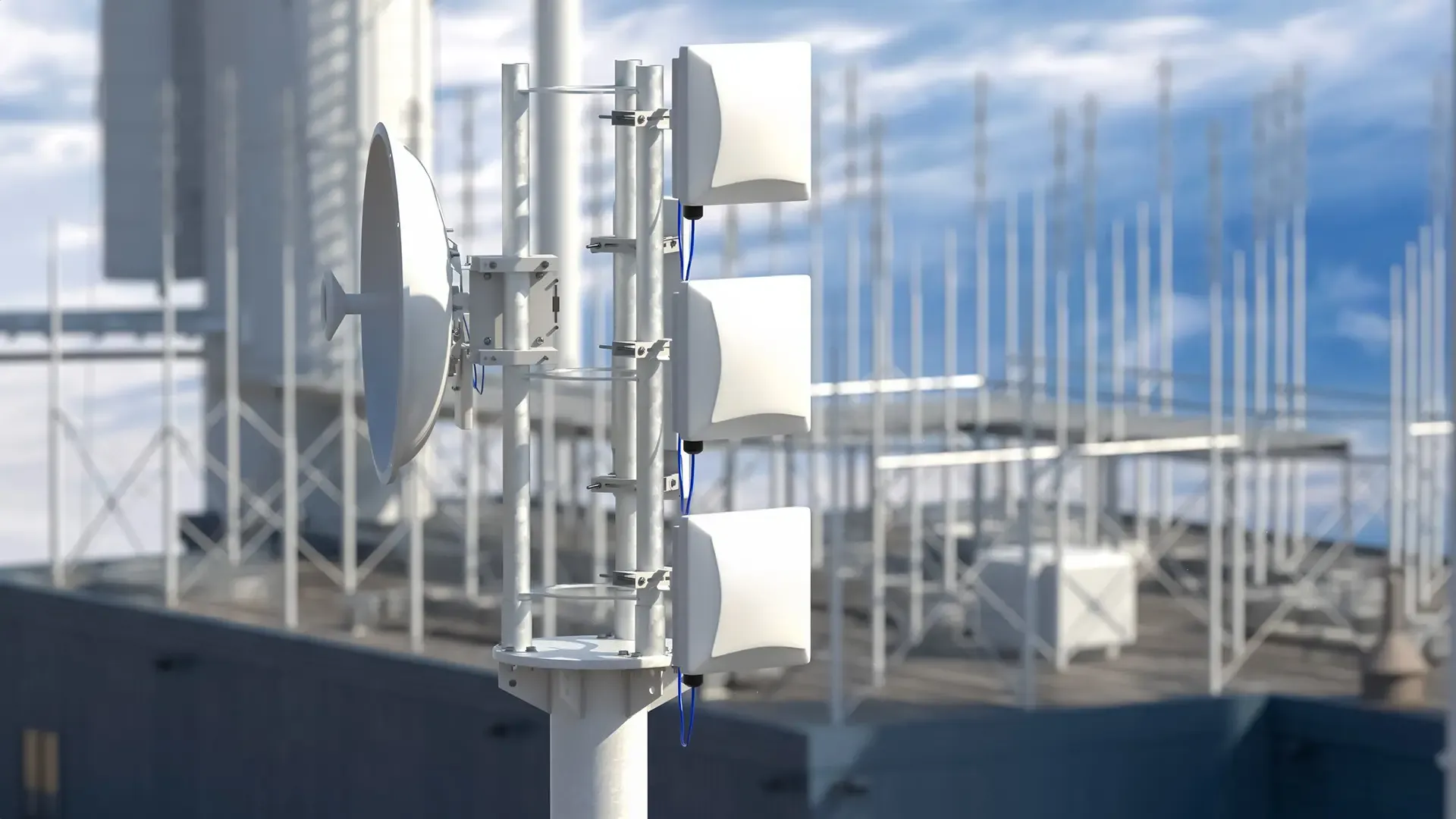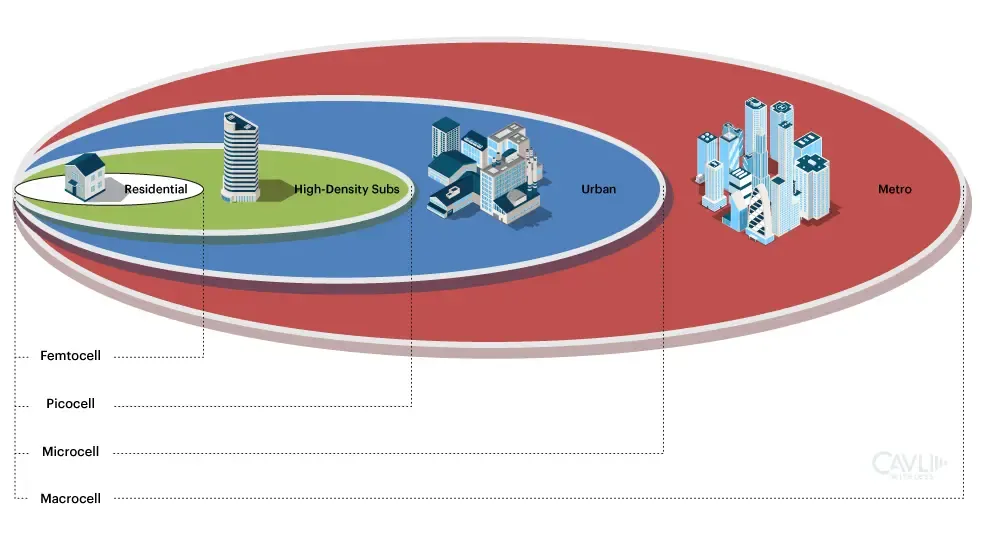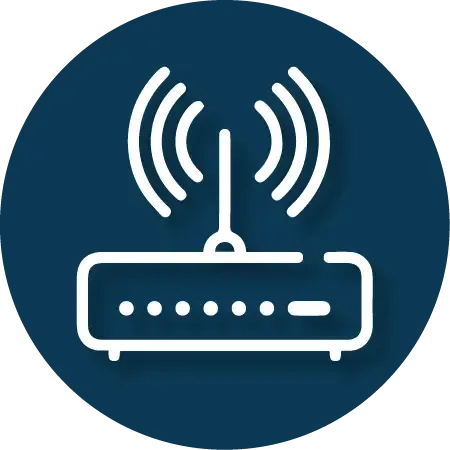James, Jr. Network Engineer
Hi Adam, I heard that 5G small cells are gaining traction. Can you fill me in on small cells?
Adam, Network Engineer
Certainly. Small cells are used to complement macrocells in crowded urban environments. A single macrocell cannot handle thousands of simultaneous connections for mobile users and IoT devices. Hence, Small cells are used to balance the load and manage the congestion in the cellular networks.
James, Jr. Network Engineer
Considering the high user density in urban environments, what's the ideal density of small cell deployments to achieve reliable connectivity for users, while also considering potential space constraints for installation?
Adam, Network Engineer
Small cells are not like the typical cell tower we are familiar with. They are small and compact just the size of a Wi-Fi router! They are usually mounted on street lights, utility poles or building walls. The deployment density of small cells in urban areas can be quite high, often in the range of 10 small cells per square kilometer or even higher, depending on the specific coverage requirements.
James, Jr. Network Engineer
Well, this is insightful. Now with the introduction of 5G networks, what are the technological advancements incorporated in 5G small cells compared to earlier ones?
Adam, Network Engineer
Small cells have been part of wireless network infrastructure for the longest period of time. They are undergoing constant advancements with the network technology advancements. With 5G introduction, small cells now support Integrated Access and Backhaul (IAB) technology eliminating dependency on fiber optic cables. It also leverages other 5G features like Dynamic Spectrum Sharing (DSS), Network Functions Virtualization (NFV) and Software-Defined Networking (SDN) to enable more flexible and dynamic network management.
Small Cells: The Little Giants of Modern Cellular Networks
As James begins to grasp the significance of small cells in network architecture, you might be wondering: what exactly are these small cells? Imagine experiencing a seamless streaming in your favorite corner of the home or having a smooth facetime with your boss, despite being in a crowded mall. It's all thanks to the little giants of connectivity— Small Cells. Let's dive into the world of these tiny yet powerful devices to uncover how they keep you connected, no matter where you are.
What is a Small Cell?
How does a network box, the size of a pizza package fix your day-to-day connectivity needs?
Small cell technology was introduced in the mid-2000s. Since then small cells have been associated with different network technologies.
For instance, have you come across APs (access points) in your office spaces?
Yes, Wi-Fi powered small cells are used to enhance network coverage and capacity in dense environments, such as stadiums, convention centers, or large public spaces.
Similarly, small cells are used as gateways or repeaters to extend the coverage and capacity of LoRaWAN (Long Range Wide Area Network) networks. Also, small cells work with LPWAN technologies like Sigfox, NB-IoT, or Cat-M1 to extend the network capacity.
The small cell development and deployment in cellular networks gained momentum with the advent of 3G networks and continued to evolve with 4G LTE technology. The introduction of 5G networks further accelerated the adoption and advancement of small cell technology, incorporating new 5G features and capabilities to support the higher data rates, lower latency, and increased device connectivity.
These low-powered radio access nodes bridge the suburban connectivity gaps. As mobile data demands continue to surge, small cells emerge as a cost-effective and scalable solution, enabling seamless connectivity for data-intensive applications, enabling and boosting overall network performance.
Small cells are an integral part of wireless communication technology, designed to provide increased cellular coverage and capacity in densely populated urban areas and inside buildings where cellular networks services experience high demands.

Small Cells
Small cells act as base stations, effectively transmitting and receiving signals over short distances. The range of a small cell is generally between 10 meters to a few hundred meters, depending on the environment, the type of small cell, and the technology used. Small cells typically cover small geographic areas such as urban neighborhoods, shopping centers, or dense indoor environments like office buildings and malls.
Role of Small Cells in Urban and Indoor Network Enhancement
Small cells operate in a more targeted approach in enhancing the cellular network capacity and coverage, particularly in areas where larger cell towers cannot provide sufficient service due to physical obstructions or high user density.
Have you seen Vision from the Marvel universe phasing through walls?
Small cell signals can also similarly phase through solid structures, eliminating dead zones by slipping into places where traditional tower signals can't reach. Small cells are mostly used for private network deployments like enterprise campuses, industrial facilities, and smart cities.
Working of Small Cell Technology: How do Small Cells Work?
Imagine a bustling city where connectivity is key, and everyone relies on their mobile devices for work, entertainment, and staying connected. The city’s main cellular towers, known as macrocells, cast their signals far and wide. The possibility of dead zones and congestion at high-consuming spots are higher.
Here enter the small cells, the small yet powerful heroes of the city’s network to fill in the gaps and ready to boost the signal wherever needed.
- Each small cell connects back to the larger mobile network through traditional wired broadband (like DSL or fiber) or wireless methods (such as microwave or satellite). This is known as backhaul. The backhaul ensures that small cells can transmit and receive data efficiently and connect with the mobile operator’s core network. The stronger the backhaul, the more data traffic the small cells can handle.
- Small cells operate on both licensed and unlicensed spectrums. In licensed spectrums, they use the same frequencies as the main cellular network, but at lower power levels. The unlicensed spectrum is more like a community radio, sharing frequencies with other types of communications like Wi-Fi. Here, small cells must carefully coordinate to avoid any interference, ensuring smooth and clear communication for users.
- Once the frequency is assigned, Small cells use advanced signal processing techniques, such as beamforming, and MIMO to minimize interference and ensure a clear communication within their service areas.
- Small cells and macrocells work together as part of a seamless team known as a heterogeneous network. Small cells keep the city’s network strong and reliable, ensuring that every call, message, and data stream is delivered with precision and speed.
Elevating Urban Network Performance with 5G mmWave Small Cells
The role of small cells is continually rising with the introduction of each generation of cellular networks. 5G small cells utilize 5th-generation cellular network technology to augment the heavy lifting that Macro cells are required to do in concentrated areas on a 5G network.
The influential factor that leads to the usage of small cells in the 5G network is the introduction of 5G mmWave. Conventional macrocells do not support ultra-fast mmWaves, so we can only harness the 5G capabilities in the miniature base stations-small cells. To get a comprehensive outlook of mmWave frequencies and their characteristics, explore our blog on the 5G mmWave spectrum.
Small cells offer versatile connectivity, supporting both indoor and outdoor deployments to address connectivity needs. It can also be used for fixed wireless access, providing a broadband internet connection as an alternative to cable or fiber.
Small but Mighty: Familiarizing The Diverse Types of 5G Small Cells
Small cells are categorized into different types based on their coverage range and power output. The main types of small cell, according to the increasing coverage hierarchy are femtocells, picocells and microcells. Each serves a unique purpose and is deployed based on specific network requirements and environments.

Different small cells and their network coverage
- Femtocells are the smallest cell covering areas up to a few meters, perfect for indoor residential coverage and low population density areas.
- Picocells cover areas up to several tens of meters, ideal for indoor high-density locations like malls, airports, and stadiums.
- Microcells are smaller cells covering areas up to several hundred meters, designed for indoor and outdoor urban coverage and high population density.
Whereas, Macrocells are large cells covering wide areas (up to several kilometers), typically for outdoor coverage in rural or suburban regions.
Small Cells Showdown: Comparing Micro, Pico, and Femtocells with Macrocells
| Factor | Macrocells | Microcells | Picocells | Femtocells |
|---|---|---|---|---|
| Bandwidth | 60-75 MHz | 20, 40 MHz | 20 MHz | 10 MHz |
| RF Output Power | 10-40 W | 2-10 W | 0.250 W | 0.20-0.1 W |
| Sector | 3 | 3 | 1 | 1 |
| Maximum Radius | 10-40 Km | 2 Km | 200 m | 10-50 m |
| Maximum Users per Sector | >200 | Up to 200 | Up to 100 | 10 |
| Indoor/Outdoor | Outdoor | Indoor and Outdoor | Indoor and Outdoor | Indoor |
| Backhaul | Microwave, OFC (Optical Fiber Cable) | Microwave, OFC | DSL (Digital Subscriber Line), Cable, OFC | Microwave |
| Installation | Operator | Operator | Operator | User |
Small Cells Powering 5G Excellence: Importance of Small Cells in 5G Technology
5G small cells in 5G networks play a crucial role in providing low latency connectivity. The 5G network employs high-frequency millimeter waves for its operations and hence many small cells are required in dense urban areas to provide seamless 5G network coverage and capacity.
How Small Cells Fuel 5G Speed?
5G small cells employ advanced 5G technologies to optimize its operation to the next level.
mmWave Operations
5G small cells operate in millimeter wave frequency bands (28GHz and 39GHz) to support multi-gigabit throughput speeds.
Antenna Technologies
Small cells integrate advanced 5G antenna technologies like massive MIMO to maximize spatial multiplexing of data streams.
Multiplexing and Modulation Techniques
5G small cells are used to transmit multiple sub-carriers. Sub-carrier is a tiny, narrowband channel that carries a small portion of the original data stream. It use (OFDM Orthogonal Frequency Division Multiplexing) to transmit data over multiple subcarriers and QAM (Quadrature Amplitude Modulation) to modulate the subcarriers.
Networking Architecture Approaches
5G small cells also support network slicing, Software-Defined Networking (SDN) and Network Functions Virtualization (NFV), enabling operators to create multiple virtual 5G networks or "slices" optimized for different use cases like enhanced mobile broadband, URLLC, etc.
Therefore, 5G small cells are an integral part of 5G networks in delivering enhanced end-user experiences by strengthening data transfer speeds, network coverage, and negating the need for devices to compete for bandwidth.
Closing Notes
Small cell technology is a pivotal component of modern telecommunications infrastructure. Its ability to provide enhanced coverage, increased capacity, and cost-effective deployment makes it a core element in current 4G networks and future 5G implementations. As we move forward, the continuous refinement and adoption of 5G small cell technology will offer a powerful solution to bridge the gap and unlock the true potential of 5G network connectivity.
Amusing Tech Chronicles
Facts and Anecdotes Related to this Edition of Wireless By Design

Neighborhood Wi-Fi Hotspots
Think of small cells as miniature versions of cellular towers, similar to how individual homes or businesses might set up their own Wi-Fi hotspots. Just as these local hotspots provide internet connectivity within a small area, small cells offer localized cellular coverage and capacity within a neighborhood or city block.

Street Lamps
Imagine small cells as being similar to street lamps lining a road. Just as street lamps are evenly spaced to provide consistent lighting along the entire stretch, small cells are strategically placed at intervals to ensure seamless cellular coverage and capacity throughout an area.

Sprinkler System
Picture a large lawn watered by a single sprinkler head. It may not provide even coverage or reach all areas effectively. The introduction of strategically placed multiple sprinkler heads (small cells) ensures that each area receives adequate and consistent coverage.
Go Beyond and Explore
What are the advantages of small cells?
The advantages of small cells are:
- Extend coverage of cellular mobile networks in indoor regions and increase overall network capacity
- Enhancing cellular services in the areas where cellular signals are weak
- Small cells are cheaper than conventional Base Stations
- Consume low power compared to conventional BSs
- Faster deployment and easy operation
What are the drawbacks of small cells?
The disadvantages of small cells are
- Shorter coverage range compared to conventional BSs.
- Handles fewer simultaneous sessions of voice/data calls and internet browsing.
- Interference, resource management, and backhaul related issues.


